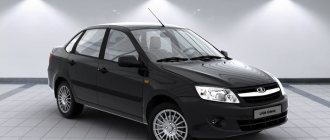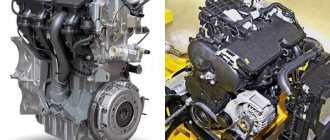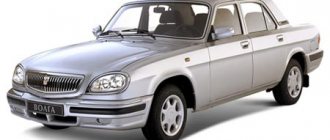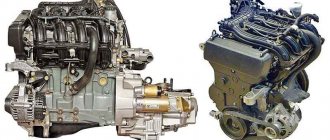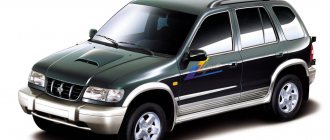Summary data for Lada Priora (before restyling 2013)
The VAZ 2170 (this is exactly the indexing that Priora received) has an improved interior compared to the “ten”, a 16-valve engine with a volume of 1596 cc. see, and a 5-speed manual transmission in all trim levels (in the first trim levels of the sedan and hatchback with an 80 hp engine, an 8-valve engine was installed). In mixed driving mode, the Priora has 100 km. it takes from 6.6 to 7.6 liters. fuel outside the city (depending on the configuration), and in the city - 9.8 liters. The new engine allows you to accelerate to 180 km/h, and to “hundreds” in 12 seconds. This property attracts the attention of fans of high-speed racing, because by working on the engine and tuning the car, you can achieve good sports performance.
Technical parameters and interior of the VAZ 2170
The two modifications differ almost only in engines. The remaining technical characteristics of the VAZ are identical. The first version of the car has a built-in 8-valve petrol engine 21116 with a volume of 1.6 liters. Fuel is supplied electronically and the 4 cylinders are arranged in a row. The maximum power of 87 forces is achieved at 5100 rpm, the maximum torque is 140 Nm, the highest speed is 176 km/h. The car does 100 in 12.5 seconds. Gasoline consumption: 9.0/5.8/7.0 liters, respectively, in the city, on the highway and in the combined cycle. The fuel tank with a volume of 43 liters must be filled with A-95 gasoline.
The second modification of the car is equipped with a 16-valve 106-horsepower gasoline unit 21127 with a volume of 1.6 liters. To develop maximum thrust, 5800 engine rpm is required. The maximum torque is 148 Nm, and the acceleration time to hundreds is 11.5 seconds. The main source of electricity is the 2170 generator, which has an adjustable voltage of 13.8 - 14.4 V.
The Lada Priora is equipped with a 5-speed manual transmission with a gear ratio of 3.7. The front has a semi-independent suspension with MacPherson struts, springs, shock absorbers and a stabilizer bar. The rear suspension is semi-independent with levers, springs and shock absorbers. Shock absorbers in both cases are hydraulic or gas-filled telescopic.
Wheels and tires are different for the two Priora modifications. The car with an 8-valve engine has 13-inch wheels. The model with a larger engine, depending on the configuration, can be “shod” with tires with rims of 13 or 14 inches.
Tires of various modifications are represented by the formulas 175/70 R13 (82, T); 175/65 R14 (82; H), The marking is deciphered as follows: 175 - tire width, mm; 70 (65) — ratio of tire profile to width in%; R — tire type (radial); 82 and T, respectively, are the load and speed index.
The interior of the VAZ Priora is distinguished by good spaciousness. When getting into the cabin, a person taller than average can fit comfortably in height; their legs also do not rest against the back of the front seat. The upholstery of the chairs is made of high quality fabric.
How much does Lada Priora weigh?
The weight of the car before restyling in 2013 was as follows:
- The 3-door hatchback coupe, 5-door hatchback and sedan have a curb weight (which includes the weight of a full tank of fuel and the driver) of 1088 kg. In this case, the total weight (i.e., the maximum permissible weight of the vehicle at which it can be operated after being fully loaded) is 1578 kg;
- The station wagon, with the same curb weight, is able to take a little more cargo, and its total weight reaches 1593 kg.
Thus, the station wagon is the most load-carrying of all Priora body types.
How long does a gas tank last?
With the maximum filling of the gas tank, the Lada Priora, powered by AI-95 (according to the passport!) will travel:
- 438 km in the city;
- 767 km on the highway;
- 597 km combined cycle.
However, the driving range on a full tank is given by us as a rough estimate, since depending on the configuration and modification it may vary slightly, although in all cases the volume of the gas tank is the same: 43 liters.
Cargo capacity
Cargo capacity (not payload!) of the Prior varies depending on the body type. So, trunks have different volumes:
- 360 liters – for hatchback and coupe;
- 430 liters - for the sedan;
- 444 liters - for the station wagon.
As we can see, this volume is not very different from the sedan’s, so it’s a very stretch to say that the Priora station wagon was created to solve a wide range of economic problems (relative to other variants of this car). Of course, cargo capacity increases significantly if you fold the back of the rear sofa, or even better, remove the entire rear seat.
Dimensions of VAZ 2170 and other modifications of Priora
The dimensions of the car are something that needs to be taken into account when purchasing, since the dimensions of parking spaces, garages, turns or entrance arches are not always universal. The height is measured from the extreme point of the front to the extreme point of the rear bumper. The width is measured at the widest point, and the height is measured from the surface of the ground to the highest point of the roof. Roof rails and racks do not fit into the height of the body. Taking this into account, the dimensions of the Priora are as follows:
- The longest body of cars in this family is the sedan. It measures 4350 mm in length. But at the same time it is the lowest - 1420 mm. in height.
- The next longest is the station wagon, with its 4340 mm length. It is the highest in height – 1508 mm.
- The five-door hatchback and three-door coupe are the shortest - 4210 mm. at 1435 mm. in height.
In all four cases, the width of the Priora is the same - 1680 mm. Ground clearance is 165 mm, although in the Priora Sport configuration it is somewhat reduced, but this is no longer so important, since this car is no longer produced in this version.
Technical characteristics of Lada Priora sedan VAZ-2170
| Car modifications | 2170 1.6 | 2170 1.6 16V |
| Engine | ||
| Engine location | Front transverse | |
| Engine capacity | 1596 cm3 | |
| Number of cylinders / Valves per cylinder | 4 / 2 | 4 / 4 |
| Supply system | Distributed injection | |
| Power (hp/rpm) | 80 / 5200 | 98 / 5600 |
| Torque (Nm/rpm) | 120 / 2700 | 145 / 4000 |
| Fuel type | AI-95 | |
| Transmission | ||
| Wheel formula / drive wheels | 4X2 / front | |
| Transmission | mechanical | |
| Number of gears | 5 | |
| Steering | ||
| Type | Rack type | |
| Amplifier | Eat | |
| Brake system | ||
| Front brakes | Disk | |
| Rear brakes | Drums | |
| Body | ||
| Body type / number of doors | Sedan / 4 | |
| Number of seats | 5 | |
| Length | 4210 mm | |
| Width | 1680 mm | |
| Height | 1435 mm | |
| Wheelbase | 2492 | |
| Front wheel track, mm | 1410 | |
| Rear wheel track, mm | 1380 | |
| Clearance | 160 mm | |
| Trunk volume | 360 / 705 | |
| Curb weight | 1088 | |
| Permissible weight | 1578 | |
| Performance characteristics | ||
| Acceleration time to 100 km/h | 14 s | 11.5 s |
| Maximum speed | 172 km/h | 183 km/h |
| Tire size | R14 (175 / 65) (185 / 65) | |
| Fuel consumption urban cycle (l/100 km) | 8.3 | 8.5 |
| Fuel consumption extra-urban (l/100 km) | 6.6 | 6.7 |
| Volume of the tank | 43 | |
www.vazdriver.ru
Modifications of Lada Priora until 2013
VAZ 2170 Lada Priora I generation cars have the following body options: 4-door sedan, 5-door hatchback and station wagon, and 3-door coupe. Depending on the year of manufacture and configuration, engine power may vary, which looks like this.
Engine Lada Priora 2007, sedan, 1st generation
Based on the configuration, sedans before the 2013 restyling are equipped with the following engines:
- 80 “horses”: 8 valves, maximum speed 172 km/h, gasoline consumption – 7.6 liters. for every 100 km. in a mixed cycle.
- 16-valve engine with 89 hp. reaches speeds of up to 176 km/h, consuming 7.3 l/100 km. paths in a mixed cycle. As you can see, in terms of its characteristics, this engine is not much different from its “younger brother,” although it consumes a little less gasoline.
- 16-valve 98-horsepower engine: maximum speed 183 km/h, AI-95 consumption in the combined cycle – 7.2 l/100 km.
Engine Lada Priora 2008, hatchback, 1st generation
5-door hatchbacks have been produced since 2008. Depending on the configuration, they are equipped with:
- 80-horsepower 8-valve engine, delivering the same speed and fuel consumption characteristics as in the case of a sedan equipped with the same engine;
- 16-valve engine with 89 hp, which produces the same speed for a hatchback and consumes the same amount of gasoline as a sedan with the same engine;
- A 98-horsepower 16-valve engine, thanks to which the hatchback completely matches the speed and consumption characteristics of a sedan with the same power plant.
Engine Lada Priora 2008, station wagon, 1st generation
With a station wagon everything is simpler. From the very beginning of production, it had only one, but the most powerful engine at that time, producing 98 l/s, which accelerated the car to 183 km/h and consumed 7.2 liters of gasoline per 100 km. paths in a mixed cycle. Thus, despite the large cargo capacity of the station wagon, its rated speed remains the same as that of other Priors in a different body version, but with the same engine, since the curb weight is the same for all modifications. Probably, when fully loaded, the station wagon will show slightly lower speed or higher fuel consumption characteristics.
Engine Lada Priora 2010, coupe, 1st generation
Since 2010, Priora has received another modification - a three-door coupe-hatchback. Everything with him is also quite simple, because... It is equipped with a 98-horsepower 16-valve engine, giving a top speed of 183 km/h, consuming 7.4 liters of gasoline per 100 km in the combined cycle, i.e. slightly more than all other body modifications. As you can see, the station wagon and coupe do not have such a wide engine variation as the 5-door hatchback and sedan, since cars of such a body are not designed for wide sale, but for specific needs: sports and motor tourism. By the way, the creators of Priora had the idea to launch a convertible into series, but reasonably considering that it would not find its buyer, they abandoned this idea.
Body modifications of Lada Priora
At the time of presentation, the VAZ Priora model was presented in three body styles:
- Sedan;
- Hatchback;
- Station wagon.
A year and a half after its debut, the Lada Priora Coupe was presented to the public.
Sedan
In body version, the Lada Priora sedan is manufactured in the following trim levels: Standard, Norma, Norma Climate, Comfort, Image. All five trim levels are equipped with a 1.6-liter power unit with a power of 106 hp. The exception is the “Standard” version 87 hp. Fuel consumption is at the level of 5.6 - 5.9 liters. / 100 km.
Hatchback
The version has only two trim levels: Standard and Lux. There are no significant differences between them. Power unit type 1.6 l., 106 hp. Front-wheel drive, acceleration to hundreds in 11.5 seconds, top speed 183 km/h. Fuel consumption is at 5.5 in mixed mode, 6.6 outside the city, 8.5 in the urban cycle.
Station wagon
Lada Priora equipment: Norma, Lux, as in the hatchback version. The power plant is typical 1.6 liters, power 106 hp. Transmission type: automatic, mechanical, front-wheel drive.
Acceleration to hundreds in 11.5 seconds, top speed 183 km/h. Average fuel consumption is 5.5 liters. / 100 km, in the city 8.9 liters, outside the city 6.8 liters.
Restyling Lada Priora 2013
The 2013 restyling consisted of some changes regarding the appearance, some equipment, interior and engine. Among such changes in Prior we will name:
- A slightly modified exterior geometry, which, however, makes no sense to describe, since visually Priora before and after restyling remained almost indistinguishable in appearance;
- Replacing the radiator grille with an elongated “honeycomb”, slightly tilting the car into the now fashionable “organic” style, characterized by biological forms;
- Improved external lighting technology, thanks to which the car’s dimensions have become clearer in the dark. In particular, the area of the reflectors has been increased, LED sections for side lights and brake lights have been added, which are both brighter and more responsive when switched on;
- A dashboard that is implemented differently: instead of four “dials,” the sensor arrows were arranged in two, without compromising functionality. Purely aesthetically it looks better, but from an ergonomic point of view, a lot depends on habit;
- An increased number of pictograms flashing on the dashboard, making it easier to figure out which lighting equipment is faulty;
- An added niche in the center of the dashboard, in which the on-board computer is placed;
- Extended front seat slides, allowing tall drivers and front passengers to adjust their seat positions more flexibly;
- A box that is more spacious in depth to the right of the driver;
- A more attractive three-spoke steering wheel with an airbag under a triangular cover;
- In the “luxury” configuration – leather upholstery based on a combination of auto fabric and eco-leather;
- New door card design.
Also, since 2013, Priors have been produced in a different engine configuration, from which the 80-horsepower engine was removed, but a new 106 l/s engine was added, which, like everyone else, reaches speeds of up to 183 km/h and reduces fuel consumption to 6. 8 – 6.9 liters per hundred km. This engine is equipped with the “luxury” configurations of the Priora. Of course, such a reduction in fuel consumption is very attractive to the consumer. We can only hope that the developers will continue to work in this direction. In addition, the new engine fits well into Euro-3 and Euro-4 environmental standards, thanks to the closely located catalyst. Due to rapid heating, the catalysis of toxic substances occurs more vigorously, as a result of which a lower concentration of them enters the atmosphere.
The restyled Prior also has a drawback (compared to previous editions of this car): the carpet in the trunk is thinner than its predecessors, which is why the noise level while driving is higher. Motorists are advised to take care of additional sound insulation in the trunk. In addition, the curb weight of the car has increased (to 1185 kg), which is by as much as 100 kg. reduced its cargo capabilities, since the maximum weight remained the same - 1593 kg. for a station wagon, and 1578 kg. for other body variations.
Facelift
On the training ground we looked like children looking for differences in two seemingly identical pictures. So, looking back at the pre-restyling car, which we immediately dubbed old, we begin to bend our fingers, counting the updates. The front bumper, which appeared on the model last year, has not changed, so at first glance both Prioras appear the same.
The only difference is the plastic radiator grille - the new honeycomb structure has refreshed the exterior. Although at a distance the honeycombs still need to be seen. The headlights are the same. I agree with the opinions of the owners on numerous forums: they work as they should.
In the stern, the main focus is on the lights. Now in their lower part there are LEDs, which are longer lasting than ordinary lamps that are on a white car. Larger reflectors on the bumper also help to outline the dimensions. At dusk, the new lighting technology really showed itself better - it was noticeably brighter.
Configurations of Lada Priora VAZ 2170 and other modifications
VAZ 2170 is known in the following configurations:
- “Standard” is the most budget package. It lacks: audio radio, speakers, air conditioning, rear headrests, immobilizer, central locking, heated front seats, electric drive and heated exterior mirrors, fog lights, remote trunk release. The front windows are electric, the rear windows are mechanical. The engine is 81 hp, which has been discontinued since 2013, and at the moment there are no longer orders for this configuration;
- “Norma”, which is equipped with an 87-, and after restyling - only a 98- and 106-power engine. Available: audio preparation, on-board computer, electric heating and electric drive of exterior mirrors, immobilizer, anti-theft alarm and all the elements of the “standard” equipment plus some new equipment. This configuration is in greatest demand due to its price niche. When you need a car “yesterday”, you have to buy what you have enough money for now, and everyone else has to retrofit the car in the process.
- "Norma+". In fact, this is the same standard for which one or more items of equipment are set: air conditioning, audio radio with speakers, ABS + BAS, child seat mounts, heated front seats and windshield;
- “Lux” is the most rich in functionality. It has everything that the “norm+” has, and in addition: side airbags, an airbag for the front passenger, rear and front electric windows, a navigator, a multimedia system, cruise control, parking sensors, fog lights, a rain sensor, a climate system , alloy wheels, heated front seats;
- “Sport” is a special package that increases the “sports” component. This is an aerodynamic body kit: a pronounced bumper with a spoiler, side sills, a diffuser rear bumper, and a wing on the trunk lid. The wheels with narrow profile tires are also different. Ground clearance, curb weight (up to 1080 kg) and maximum weight (up to 1500 kg) have been reduced. The interior has also been transformed: side supports have been added along the edges of the seats with red stitched seams, carbon fiber inserts, and a leather steering wheel. Air conditioning, radio, and a full set of electric windows are included. However, the production of sports Prioras was limited and today they are discontinued, although they can be found here and there on the highway, and most often these are Priora coupes.
Of course, this is not a complete, but only an indicative overview of the configurations of the Lada Priora, which is hardly possible to present in its entirety within the confines of one article. In addition, the equipment also differs somewhat depending on the body type. For example:
- Prior station wagons have roof rails, brackets on the wheel arches of the trunk, for which cargo can be strapped;
- For the coupe body, folding backrests and a reinforced frame of the front seats have been developed.
